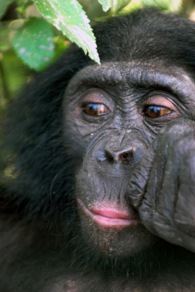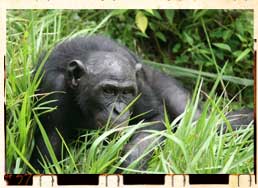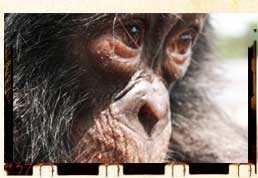BCI Australia
Bonobos (pan paniscus) are officially part of our family- the hominids (better known as the Great Apes), which consists of we humans, chimpanzees, gorillas and orang-utans. Bonobos share 98.7% of our DNA. For a long time we mistook them for their common chimpanzee (pan troglodyte) cousins, despite their trendier centre-part hairstyles. They are also slightly more slender, their infants have darker faces and redder lips and their adults retain the white rump tuft that common chimpanzees lose after infancy. They walk upright much more often and nurture their young for longer.


Bonobo (pan paniscus) |
Chimpanzee (pan trogoldyte) |
However it’s what goes on between their ears and their legs that makes bonobos so different and special. In 1954, German scientists Eduard Tratz and Heinz Heck described behavioural differences between chimpanzees and bonobos in the Munich Zoo by noting, among other things, that bonobos were more sensitive and lively, much less violent and had more sex face-to-face. They concluded by saying, “the bonobo is an extraordinarily sensitive, gentle creature, far removed from the demoniacal primitive force of the adult chimpanzee.” This sensitivity is demonstrated by Kanzi, perhaps the first primate multi-media superstar, who has performed music with Paul McCartney and Peter Gabriel and been featured on the Discovery Channel. He is regarded by many as the first ape to demonstrate full comprehension of human speech, recognising more than 3000 words, and can communicate sophisticated concepts and grammar using more than 300 symbolic pictures.
It would be harder, however, to do a primetime television special on the bonobos’ vivid and rich sex lives. Along with human females, bonobo females are believed to be the only mammals not to be aware or give signs of their fertile period (this is known as “concealed ovulation”). As with human females, bonobo sex is therefore not only for procreation, but can be used for other purposes e.g. bonding, recreation, pleasure, trade, tension release and conflict resolution. A bonobo may have sexual contact with males, females, young and old, singly or all at once. Tongue kissing, masturbation and oral sex are common for both sexes. Males may hang from trees and engage in “penile fencing”, rub their penises together in the missionary position, or stand back-to-back and rub their scrotal sacs together in reconciliation after a conflict. When different groups approach a single food source, they have been observed to dispel the tension by engaging in sex before sharing the bounty. A female has been seen wooing a male only to filch the orange he was carrying after succumbing to her charms. In fact, it is through female sexuality that bonobos chalk up another remarkable characteristic- their matriarchal social structure.
Despite being somewhat physically smaller than their male counterparts, bonobo females dominate. Females have been observed getting first access to food and banding together to punish males who assault other females, or who even have the temerity to try and snatch food first. This female solidarity is cemented by frequent passionate bouts of vigorous mutual vulva frottage, often to orgasm.
Bonobos provide a marked contrast to common chimpanzees, where males constantly scheme and form tenuous alliances to physically intimidate females and other males to gain preferential access to ovulating females. And rather than having sex with rival groups, chimpanzees have been known to systematically wage war on each other until only one group remains.
While biology is not necessarily destiny, we share a common ancestor with bonobos and chimpanzees who probably lived around six million years ago. Both provide glimpses into our evolutionary heritage and it is tempting to see elements of bonobo and chimp behaviour in human interaction. In this regard it is fortunate our primate cousins are so limber for they are increasingly being contorted to suit the varied positions of various commentators on the human condition. In many ways, they are proxies for our own moral, sexual and social conflicts.
Advocates of realism in International Relations theory can find succour in the zero-sum machinations of chimp politics and their war-of-all-against-all, while pacifists and idealists draw lessons from the cooperative and reconciliatory bonobos.
The natural exuberance of bonobo sexuality, free of guilt and shame, gives anthropological weight to the hippy motto, “make love, not war”, and their same-sex shenanigans lends alternative examples to those oppressed by the notion that man is created in the image of a heterosexual god. Their matriarchal social structure demonstrates that brutal patriarchy is not necessarily the default primate position, while Kanzi’s sophisticated language capabilities suggest a level of consciousness that blurs the boundaries typically reserved only for humanity. Bonobos provide new perspectives, if not complete answers, to ancient and profound questions
And yet we have barely begun to understand them, and some think that much of what we do know may be tainted. Bonobos are only found in the Democratic Republic of Congo, deep in the Congo Basin, the world’s second largest rainforest. Historically, they have been hard to visit, hard to find and hard to observe in their natural habitat. The bulk of bonobo observations to date, therefore, have been from captive animals or from wild animals drawn to a clearing with provisioned food. Science has also been a victim of recent wars in the Congo that killed nearly four million people, the greatest human slaughter since World War II. Only in the last few years has the security situation stabilised enough to allow researchers to return.
But the difficulties experienced by bonobo researchers pale next to the challenges faced by the bonobo as a species. While habitat destruction through logging is a significant threat, the bushmeat trade is the biggest killer. Bonobos are eaten by many who are starving and have no other protein source or killed by poor hunters who have no other financial source but to feed the growing demand in urban centres for bushmeat. It is extremely difficult to see bonobos, let alone conduct a census, but some experts estimate a decline from 200,000 in 1976 to possibly less than 10,000 today.
Socrates instructed, “Know Thyself”. Plato said, “The unexamined life is not worth living.” Similarly, Shakespeare told us, “to thine own self be true”. Bonobos have so much to teach us about ourselves but we are likely to slaughter them all within a generation if we don’t take action now.
Together with our BCI partners in USA and DRC, BCI Aust. is dedicated to ensuring the survival of bonobos and their rainforest habitat in the Congo Basin, and to promoting awareness of bonobos amongst Australians.












